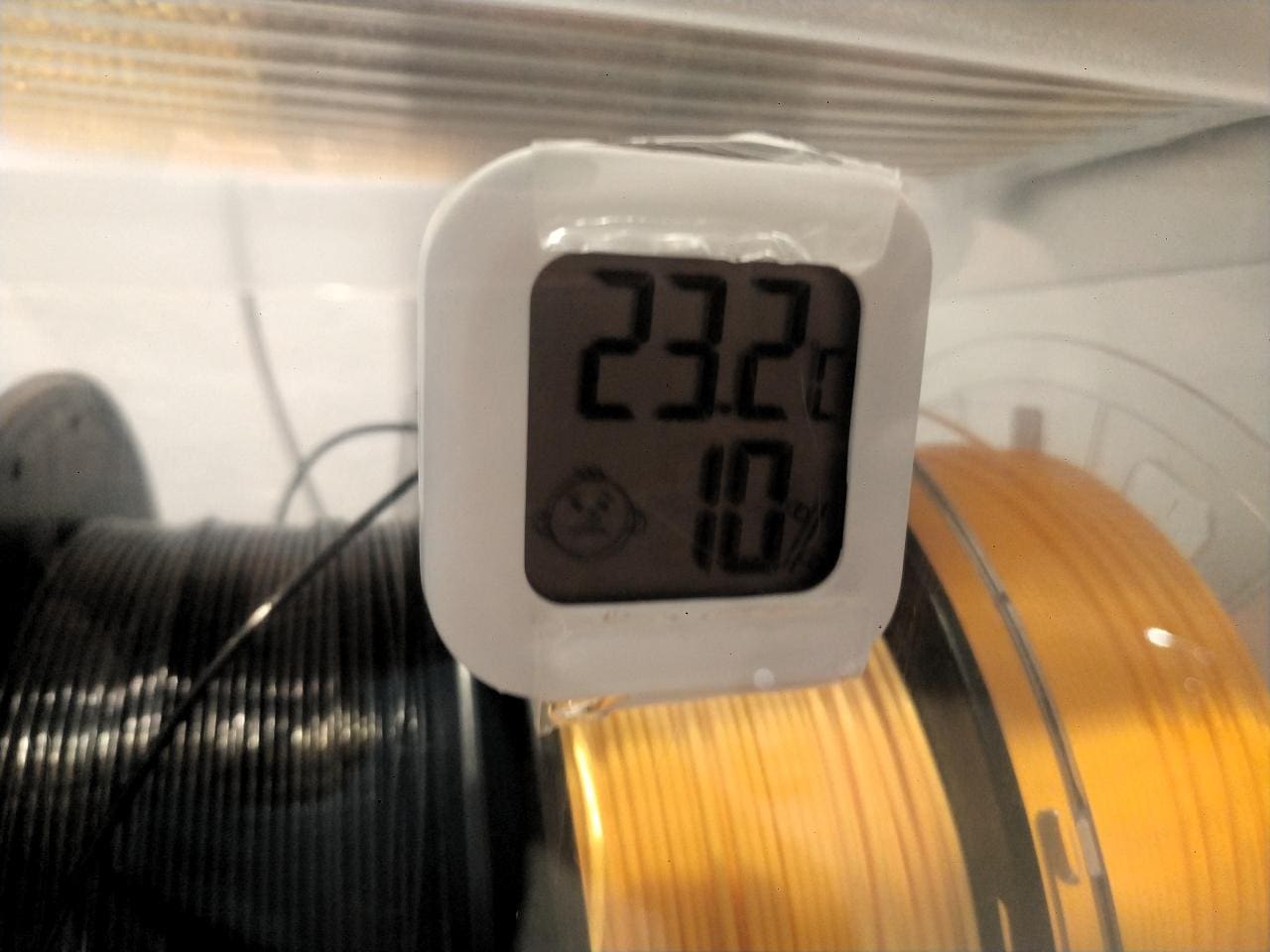Inhalt:
A few days ago I bought filament boxes at a fun price from the Action market. Time for an upgrade and a test.
Upgrades
I ordered 1 kg of silica gel, orange with indicator, 12 organza bags and 6 mini thermo/hygrometers on Amazon for Prime Day. Fun fact: despite Prime, they don’t deliver on the promised date, but only a week later. Meanwhile, the delivery date for the items ordered is still shown as the next day.
Only the silica gel arrived on time. But that was also sent by a Marketplace participant(nagamil – Marius Haas).
In addition to six 19-litre boxes with lids, I bought two packs of silicone sealing tape, each six metres long. Good stuff, costs less than 3 EUR. To attach the hygrometers, I chose nano double-sided adhesive tape for 2 EUR. It’s transparent and very thick. It also sticks like hell, which makes it difficult to cut cleanly.


Cost
The upgrade totalled 38 EUR, the boxes came to 24 EUR.
So I paid atotal of 62 EUR, which is 2.58 EUR per roll.
Comparison with the popular and well-known muesli boxes? Gladly: 5.25 EUR per box, no sealing tape required, the rest the same – that’s 157 EUR or 6.55 EUR per roll. The advantage of cereal boxes: if you only have a few rolls of filament, the individual packaging is easier to handle.
Application
I stuck the hygrometers to the inside of the boxes using the nano tape. The sealing tape was placed in the lid. As you can’t get round the corners, you have to cut it to size with a cutter knife. Yes, these are also available at Action. I love the Action market, they have good quality at really favourable prices.

Effectiveness
How quickly does the humidity in the box drop?

After one hour, the humidity in the box has dropped by 30%.

Here you can clearly see that the Nano-Tape from the Action sticks so well that it cannot be cut off cleanly even with a cutter knife, as the blade sticks to it when cutting.
After two hours, the humidity dropped to 10 per cent. According to various forums, this seems to be a normal value in reality. Theoretically, silica gel could reduce the humidity in a closed system to 0 per cent. If you want to know more about this: * click* But beware: this is very scientifically analysed.
Test
Do these boxes really need sealing tape? Is there really that much humid air getting into the boxes? How can this be tested? By fitting one box with sealing tape and open rolls and one without sealing tape with welded rolls.
The box in which the silica gel is darker after a few weeks is either tighter, which can be assumed with a sealing tape, or the filament still had residual moisture in it.
I left the PLA to dry for six hours at 50 degrees in a convection oven with the door slightly open. PLA is not as hygroscopic as other filaments.


Okay, you can’t really see it in the pictures, but the silica gel in the box with the open filament has become much darker. This means that it has absorbed more water. Some test spheres that were outside turned completely black during this time.
For me, this means that the seals are somewhat overrated – or that I still need to put clips on the sides of the lids. However, I simply suspect that drying in the oven was not able to remove all the moisture from the PLA that had accumulated in four years of open storage.
Where are the bags?
Oh, the silica gel absorbs the moisture in the air more quickly when spread open in the box than in a bag. The disadvantage, however, is that I have to transfer the material to a baking tray to regenerate the spheres without spilling a significant amount.
Regeneration
It is recommended to regenerate the silica gel for 90 minutes per 0.5 kg at 120 degrees circulating air. In my case, this is three hours. In between, I would open the oven door several times to let the moist air out. After regeneration, the colour should turn back to a cheerful orange.
While the filament was drying, I noticed that the air was really humid when I opened the oven door. You (I) really underestimate the absorption capacity of filaments.
To prevent the silica gel granules from absorbing moisture from the room air again when they cool down, they should be placed in a heat-resistant container with a lid. For example, old jam jars or preserving jars. Once it has cooled down, put it back into the boxes.
Conclusion
Was the upgrade worth it? Yes, definitely for the silica gel. The hygrometers are a nice add-on for the control freak in you. I will try out the organza bags when I get the chance, but I would only really use them if I wanted to use one of the cereal boxes mentioned above for very special, very sensitive filaments.
Here is a list of the sensitivity of the filaments.
UPDATE!
The sealing tape from the Action proved to be too thick. In some boxes, the lid bulged in the centre and air was able to get in.
I ordered 12mm x 1.5mm sealing tape from Amazon, which fits much better. It is ten metres long, which is perfect for eight boxes. You can bend the tape a little around the curves and then cut it off at an angle. You can continue with the cut-off corner on the other side, so there is no waste.
Eight boxes? Yes, I bought two more boxes. Had to buy them. One is (still) empty, but I still want rainbow filament, matt TPU and a wood filament. The nozzle in the Qidi is nickel-plated, because wood filament is abrasive and destroys normal brass nozzles.
Pictures say more than 1,000 words:






